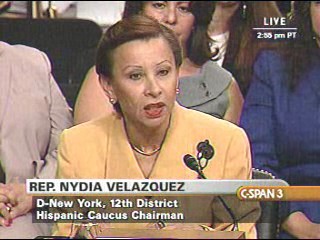Home >> Newsroom >> Nydia in the News
Red Hook Trolley Idea Picks Up Support
Velázquez Requests $10 Million
By Raanan Geberer
August 25, 2009
BROOKLYN — Along with Mayor Michael Bloomberg, Brooklyn Congresswoman Nydia Velázquez is calling for funding for a Red Hook trolley, or streetcar, system.
In her request for funding for the Fiscal Year 2010 surface transportation bill, she has included $10 million for “design and construction of a light rail system along the Brooklyn waterfront from Red Hook to Downtown Brooklyn, Brooklyn, N.Y.”
At a campaign rally earlier this month, Bloomberg unveiled his ideas for overhauling the city’s transit system — streetcar service being one of them. Velázquez’s request was made in May, prior to Bloomberg’s statement.
Bloomberg’s transportation commissioner, Janette Sadik-Khan, also said recently that positive experiences with streetcars in Toronto and Portland made her want to explore a trolley system in Brooklyn. The Department of Transportation (DOT) has now begun a $259,000 feasibility analysis of placing streetcar lines in Red Hook, DUMBO and other waterfront areas, according to published reports.
A network of electric trolleys once crisscrossed Brooklyn, but they were phased out in stages during the 1950s. The Red Hook plan is very similar to one put forward by Flatbush rail fan Bob Diamond in the late 1990s and early 2000s.
Diamond’s volunteer-driven organization, the Brooklyn Historic Railway Association, obtained some trolley cars, most of them from Boston, and started laying tracks and overhead wires in the area. Property owner Greg O’Connell gave him space to store his trolleys in one of his warehouses. The DOT gave Diamond funding for the first phase of the work, but in 2003 the project came to a standstill after the agency demanded that Diamond come up with more private funding.
Diamond told the Eagle by e-mail that “This idea [mentioned by Velázquez] is precisely what I called “Brooklyn Heritage Trolley Project [BHRA] Phase 3” back in 2002. In fact, I believe the $10,000,000 sum comes from a TEA-21 [Transportation Equity Act] grant application we submitted at that time, but the city declined to sponsor it.”
Still, he said, “The way I look at this is ‘better late than never.’ I’m thrilled the powers that be have come to realize it’s a worthy project.”









